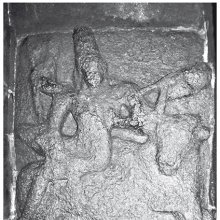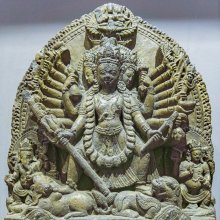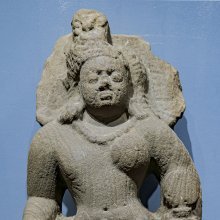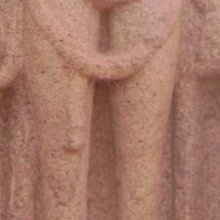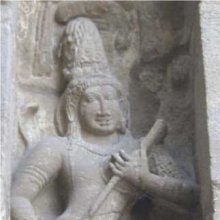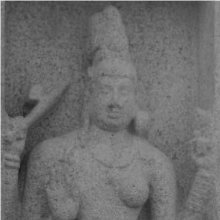Ardhanarishvara, Ārdhanārīśvara, Ardhanari-ishvara, Ardhanārīśvara: 17 definitions
Introduction:
Ardhanarishvara means something in Hinduism, Sanskrit, the history of ancient India, Hindi. If you want to know the exact meaning, history, etymology or English translation of this term then check out the descriptions on this page. Add your comment or reference to a book if you want to contribute to this summary article.
The Sanskrit terms Ārdhanārīśvara and Ardhanārīśvara can be transliterated into English as Ardhanarisvara or Ardhanarishvara, using the IAST transliteration scheme (?).
Alternative spellings of this word include Ardhnariswar.
Images (photo gallery)
(+8 more images available)
In Hinduism
Purana and Itihasa (epic history)
Source: archive.org: Shiva Purana - English TranslationArdhanārīśvara (अर्धनारीश्वर) refers to Śiva manifested as Half woman and Half man, according to the Śivapurāṇa 2.1.15:—“[...] while I was performing penance (tapas) for creation (sṛṣṭi), the merciful lord Śiva of Trinity, came out of the spot called Avimukta between the eyebrows (bhrū) and the nose (ghrāṇa). He manifested himself as Half woman and Half man (Ardhanārīśvara) in full potency. On seeing the unborn lord Śiva, a mass of refulgence, the consort of Umā, the omniscent, the creator of everything, famous as Nīlalohita, straight in front of me I saluted him with great devotion and was highly delighted. I told the lord ‘Please create various subjects’.”.
Note: Ardhanārīśvara is the half-male and half-female form of Śiva. This form, most popular in ancient sculpture, symbolises the union and concord of the spirit and its energy.
Ardhanārīśvara (अर्धनारीश्वर).—Śiva became this by worshipping Śakti:1 Image of; with details of dress and ornaments.2
Source: Shodhganga: The saurapurana - a critical studyArdhanārīśvara (अर्धनारीश्वर) represents to the “androgynous form of Śiva”, according to the 10th century Saurapurāṇa: one of the various Upapurāṇas depicting Śaivism.—Śiva sometimes appears in his androgynous form as Ardhanārīśvara, with a hermaphrodite body, uniting in himself, the principles of male and female generation. According to the Mahābhārata all creatures bear the male or female sign and as such all of them belong either to Śiva or to his female counterpart Devī.
The Ardhanārīśvara form of Śiva is said to have been born from the wrath of Rudra. The creation of the Ardhanārīśvara form is explained in the Saurapurāṇa as follows:
“Brahmā tried his best at creation from couples (mithunaiā sṛṣṭi) but was unsuccessful. He propitiated Śiva, who became half man and half woman and separated Pārvatī from his body for procreation. Elsewhere it is said that Pārvatī praised Śiva after she killed the demon Mahiṣa. Being pleased Śiva got her absorbed in the left half of his body. Half of his body then remained white like camphor, the other half became reddish; in one half were seen long hair with a flower wreath. In one side of the face was the ear-ornaments, on the ankle was anklet; on the other side of the head was the half-moon, in one half was seen a woman’s breast”.
The Ardhanārīśvara form emphasizes the mental approach of reconciliation of the principal cult deities of Śaivaism and Śaktism. This shows that the supreme Deity is the father and the mother of the Universe at the same time. It points out that the supreme spirit eternally transforms Himself into numberless finite spirits and material objects and also eternally transcends them, illumines them, unifies them and is untouched by the changes occuring in them. [...]
The Ardhanārīśvara is the model of conjugal inseparability. This form is definitely a development of the Upanisadic myth of the Ātman “Who was as large as a man and a woman closely embraced”. The predilaction of Indian mind for such as a form depicting this divine male-female polarity seems to be no chance occurrence. In later stage this conveys the Sense of toleration of these two cults like Śiva and Śakti. This form also emphasizes the need to look upon woman as equal and complimentary to man.

The Purana (पुराण, purāṇas) refers to Sanskrit literature preserving ancient India’s vast cultural history, including historical legends, religious ceremonies, various arts and sciences. The eighteen mahapuranas total over 400,000 shlokas (metrical couplets) and date to at least several centuries BCE.
Vastushastra (architecture)
Source: Shodhganga: Temples of Salem region Up to 1336 ADArdhanārīśvara (अर्धनारीश्वर).—Ardhanārīśvara is situated on a hillock, facing west, in the heart of Tiruchengodu. This is a rare temple, where the sanctum enshrines an image of hermaphrodite form of Śiva, (fig 48) as against the usual practice of installing 320 the Liṅga. The main shrine probably possessed only a garbhagṛha and ardhamaṇḍapa on plan, which is now included into a gūḍhamaṇḍapa of a later date. The main shrine has inscriptions of Raja Raja I and his son Rajendra Chola. By this it may be inferred that this shrine existed during the last decade of the 10th century.

Vastushastra (वास्तुशास्त्र, vāstuśāstra) refers to the ancient Indian science (shastra) of architecture (vastu), dealing with topics such architecture, sculpture, town-building, fort building and various other constructions. Vastu also deals with the philosophy of the architectural relation with the cosmic universe.
Shilpashastra (iconography)
Source: Archaeological Survey of India: Śaiva monuments at Paṭṭadakal (śilpa)Ardhanārīśvara (अर्धनारीश्वर) is found as a sculpture at the temple of Lokeśvara, north wall, north façade.—In the case of Pārvatīparameśvara or Ardhanārīśvara like Śaṃkaranārāyaṇa, Śiva is represented in the right part and Viṣṇu or Pārvatī in his left portion. There is a dancing figure with two hands on the upper portion of the niche of Ardhanārīśvara, but it is very much worn out.
Another sculpture is found at the porch half wall, north façade.—This is another representation of a half-man half-woman form, one of the sports of Śiva, carved in a niche in the eastern entrance porch corner. It is like the one in fig. 199, but it is bereft of the beauty and the elegance of the previous one.
Ardhanārīśvara (अर्धनारीश्वर) is also found as a sculpture on the exterior (western wall) of the temple of Trailokyeśvara.—The left portion of the image represents Pārvatī and it is interesting to note that the artist has succeeded in giving her the Calukyan hairstyle by incorporating in it a portion of the jaṭāmakuṭa of Śiva. It shows the competency and the creativity of the artist. In the other portion which represents Śiva, the god has two hands, the upper with a trident and the lower in kaṭihasta. The goddess’ left hand is in dola.Probably, there was a mirror in her upper hand because there is trace of some round figure. Her ear ornament is remarkably beautiful.
Source: Shodhganga: Iconographical representations of Śiva (shilpa)1) Ardhanārīśvara (अर्धनार्यीश्वर) or Ardhanārīśvaramūrti refers to one of the eighteen forms (mūrti) of Śiva mentioned in the Kāraṇāgama (pratimālakṣaṇavidhi-paṭala): the fourth among the Siddhāntaśaivāgamas. The forms of Śiva (e.g., Ardhanārī-īśvara) are established through a process known as Sādākhya, described as a five-fold process of creation.
2) Ardhanārīśvara is also listed among the twelve forms (mūrti) of Śiva mentioned in the Suprabhedāgama: the tenth among the Siddhāntaśaivāgamas.
3) Ardhanārīśvara is also listed among the eighteen forms (mūrti) of Śiva mentioned in the Śilparatna (twenty-second adhyāya): a technical treatise by Śrīkumāra on Śilpaśāstra.

Shilpashastra (शिल्पशास्त्र, śilpaśāstra) represents the ancient Indian science (shastra) of creative arts (shilpa) such as sculpture, iconography and painting. Closely related to Vastushastra (architecture), they often share the same literature.
Ayurveda (science of life)
Rasashastra (Alchemy and Herbo-Mineral preparations)
Source: Wisdom Library: Rasa-śāstraArdhanārīśvara (अर्धनारीश्वर) is the name of an Ayurvedic recipe defined in the fourth volume of the Rasajalanidhi (chapter 2, dealing with jvara: fever). These remedies are classified as Iatrochemistry and form part of the ancient Indian science known as Rasaśāstra (medical alchemy). However, as an ayurveda treatment, it should be taken twith caution and in accordance with rules laid down in the texts.
Accordingly, when using such recipes (e.g., ardha-nārīśvara-rasa): “the minerals (uparasa), poisons (viṣa), and other drugs (except herbs), referred to as ingredients of medicines, are to be duly purified and incinerated, as the case may be, in accordance with the processes laid out in the texts.” (see introduction to Iatro chemical medicines)

Āyurveda (आयुर्वेद, ayurveda) is a branch of Indian science dealing with medicine, herbalism, taxology, anatomy, surgery, alchemy and related topics. Traditional practice of Āyurveda in ancient India dates back to at least the first millenium BC. Literature is commonly written in Sanskrit using various poetic metres.
Shaktism (Shakta philosophy)
Source: Google Books: ManthanabhairavatantramArdhanarīśvara (अर्धनरीश्वर) is the name of a deity, according to the second recension of the Yogakhaṇḍa of the Manthānabhairavatantra, a vast sprawling work that belongs to a corpus of Tantric texts concerned with the worship of the goddess Kubjikā.—Accordingly, as Bhadrakālī said to Śrīkaṇṭha: “[...] O Śaṃkara, you also displayed this, one of your forms. Thus, O lord Śaṃkara, I wish to see you, Śaṃkara. O Lord, you have appeared (before) in this way by the power of supreme knowledge. (You are) he, the Siddha who has been pierced (by the power of the Command) and, made of universal bliss, is accompanied by Yogeśvarī. He is Śaṃkara’s lord; supreme, he has five faces, three eyes, holds a spear and, adorned with matted hair and crown, (his) divine body is covered with ashes. He is the pervasive lord Ardhanarīśvara”.

Shakta (शाक्त, śākta) or Shaktism (śāktism) represents a tradition of Hinduism where the Goddess (Devi) is revered and worshipped. Shakta literature includes a range of scriptures, including various Agamas and Tantras, although its roots may be traced back to the Vedas.
Shaivism (Shaiva philosophy)
Source: Brill: Śaivism and the Tantric TraditionsArdhanārīśvara (अर्धनारीश्वर) or Ardhanārīśvaravrata refers to a type of Vrata (“observance”), according to the Guhyasūtra chapter 9.—Accordingly, “[...] [The Lord spoke]:—[...] In the left hand, he should hold a winnowing fan in the observance of Ardhanārīśvara [i.e., ardhanārīśvaravrata]. Adopting this observance he should eat alms, keep his senses under control, be devoted to regular obligatory recitation and oblation, rejecting the receipt of gifts. He should venerate God three times [a day] and perform ablutions three times [a day]. Eating vegetables and barley-gruel, eating bulbs, roots and fruits, for one month. [...]”.

Shaiva (शैव, śaiva) or Shaivism (śaivism) represents a tradition of Hinduism worshiping Shiva as the supreme being. Closely related to Shaktism, Shaiva literature includes a range of scriptures, including Tantras, while the root of this tradition may be traced back to the ancient Vedas.
India history and geography
Source: Cologne Digital Sanskrit Dictionaries: Indian Epigraphical GlossaryArdhanārīśvara.—(CII 4), a form of Śiva, in which the bodies of Śiva and Pārvatī are combined into one. Note: ardhanārīśvara is defined in the “Indian epigraphical glossary” as it can be found on ancient inscriptions commonly written in Sanskrit, Prakrit or Dravidian languages.

The history of India traces the identification of countries, villages, towns and other regions of India, as well as mythology, zoology, royal dynasties, rulers, tribes, local festivities and traditions and regional languages. Ancient India enjoyed religious freedom and encourages the path of Dharma, a concept common to Buddhism, Hinduism, and Jainism.
Languages of India and abroad
Sanskrit dictionary
Source: DDSA: The practical Sanskrit-English dictionaryArdhanārīśvara (अर्धनारीश्वर).—a form of Śiva, (half male and half female) cf.... पतिरपि जगता- मर्धनारीश्वरोऽभूत् (patirapi jagatā- mardhanārīśvaro'bhūt) Sūkti.5.99.
Derivable forms: ardhanārīśvaraḥ (अर्धनारीश्वरः).
Ardhanārīśvara is a Sanskrit compound consisting of the terms ardha and nārīśvara (नारीश्वर). See also (synonyms): ardhanārīśa, ardhanārī, ardhanaṭeśvara.
--- OR ---
Ārdhanārīśvara (आर्धनारीश्वर).—The story of the lord Śiva in his form as अर्धनारीश्वर (ardhanārīśvara).
Derivable forms: ārdhanārīśvaram (आर्धनारीश्वरम्).
Ārdhanārīśvara is a Sanskrit compound consisting of the terms ārdha and nārīśvara (नारीश्वर).
Source: Cologne Digital Sanskrit Dictionaries: Aufrecht Catalogus CatalogorumArdhanārīśvara (अर्धनारीश्वर) as mentioned in Aufrecht’s Catalogus Catalogorum:—lexicographer. Quoted by Cāritravardhana on Raghuvaṃśa.
Source: Cologne Digital Sanskrit Dictionaries: Monier-Williams Sanskrit-English Dictionary1) Ardhanārīśvara (अर्धनारीश्वर):—[=ardha-nārīśvara] m. ‘the lord who is half female (and half male)’, a form of Śiva.
2) Ārdhanārīśvara (आर्धनारीश्वर):—[from ārdha] n. ([from] ardha-nārīśvara q.v.), the story of the lord (Śiva) in his form as half female (and half male), [Bālarāmāyaṇa]
[Sanskrit to German]
Sanskrit, also spelled संस्कृतम् (saṃskṛtam), is an ancient language of India commonly seen as the grandmother of the Indo-European language family (even English!). Closely allied with Prakrit and Pali, Sanskrit is more exhaustive in both grammar and terms and has the most extensive collection of literature in the world, greatly surpassing its sister-languages Greek and Latin.
Hindi dictionary
Source: DDSA: A practical Hindi-English dictionaryArdhanārīśvara (अर्धनारीश्वर) [Also spelled ardhnariswar]:—(nm) Lord Shiv as envisaged in fusion with Goddess Parvati:.
...
Kannada-English dictionary
Source: Alar: Kannada-English corpusArdhanārīśvara (ಅರ್ಧನಾರೀಶ್ವರ):—[noun] the hermaphroditic form of Śiva as half-man and half-woman, symbolising his transcendental wholeness in which both are integrated.
Kannada is a Dravidian language (as opposed to the Indo-European language family) mainly spoken in the southwestern region of India.
See also (Relevant definitions)
Partial matches: Ishvara, Ardha, Ardhanari.
Starts with: Ardhanarishvaramurti, Ardhanarishvarashtaka, Ardhanarishvarastotra, Ardhanarishvaravrata.
Full-text (+41): Vamardhamga, Ardhnariswar, Ardhanarishvaramurti, Kritashauca, Ardhanari, Ardhanarisha, Ardhanateshvara, Tiruchengode, Umaipakan, Umaipankar, Umavana, Skanda, Grihitva, Shiva, Kanda, Phalashin, Mulaphala, Pratigrahavivarjita, Skandashin, Kandamulashin.
Relevant text
Search found 33 books and stories containing Ardhanarishvara, Ardha-narishvara, Ardha-nārīśvara, Ārdha-nārīśvara, Ardha-narisvara, Ardhanari-ishvara, Ārdhanārī-īśvara, Ardhanari-isvara, Ardhanārī-īśvara, Ardhanarisvara, Ārdhanārīśvara, Ardhanārīśvara; (plurals include: Ardhanarishvaras, narishvaras, nārīśvaras, narisvaras, ishvaras, īśvaras, isvaras, Ardhanarisvaras, Ārdhanārīśvaras, Ardhanārīśvaras). You can also click to the full overview containing English textual excerpts. Below are direct links for the most relevant articles:
Early Chola Temples (by S. R. Balasubrahmanyam)
Temples in Uyyakkondan (Tirumalai) < [Chapter II - Temples of Parantaka I’s Time]
Temples in Anangur < [Chapter VIII - Temples of Uttama Chola’s Time]
Temples in Karuntattangudi (Karandai) < [Chapter VIII - Temples of Uttama Chola’s Time]
Middle Chola Temples (by S. R. Balasubrahmanyam)
Temples in Tiruchchengodu < [Parantaka I]
Temples in Tirunedungalam < [Chapter II - Temples of Rajaraja I’s Time]
4. Icons set up By Rajaraja I’s Officers and others < [Tanjavur/Thanjavur (Rajarajesvaram temple)]
Rasa Jala Nidhi, vol 4: Iatrochemistry (by Bhudeb Mookerjee)
Treatment for fever (91): Ardha-narishvara rasa and Tridoshadavanala rasa < [Chapter II - Fever (jvara)]
The Linga Purana (by J. L. Shastri)
Chapter 33 - Statement of the Sages (ṛṣivākya) < [Section 1 - Uttarabhāga]
Chapter 99 - Destruction of Dakṣa’s sacrifice < [Section 1 - Uttarabhāga]
Chapter 41 - Nativity of Brahmā < [Section 1 - Uttarabhāga]
Hindu Pluralism (by Elaine M. Fisher)
Ardhanārīśvara Dīkṣita and the Birth of Samayin Śrīvidyā < [Chapter 2 - The Making of the Smārta-Śaiva Community of South India]
Śaṅkarācāryas and Smārta Brahmins < [Chapter 2 - The Making of the Smārta-Śaiva Community of South India]
Śaṅkarācārya Worships the Goddess < [Chapter 2 - The Making of the Smārta-Śaiva Community of South India]
Lakulisha-Pashupata (Philosophy and Practice) (by Geetika Kaw Kher)
Iconographical Explanation < [Chapter 5 - The Mythological Bridge]
Sculptural Evidence < [Chapter 1 - The Historical Context]
Historicity (of the term linga) < [Chapter 6 - Siva-linga: an Iconological Study]
Related products
